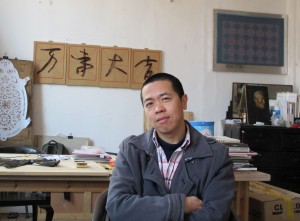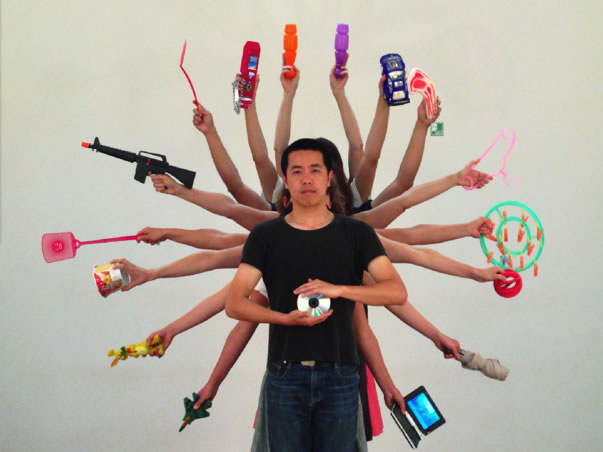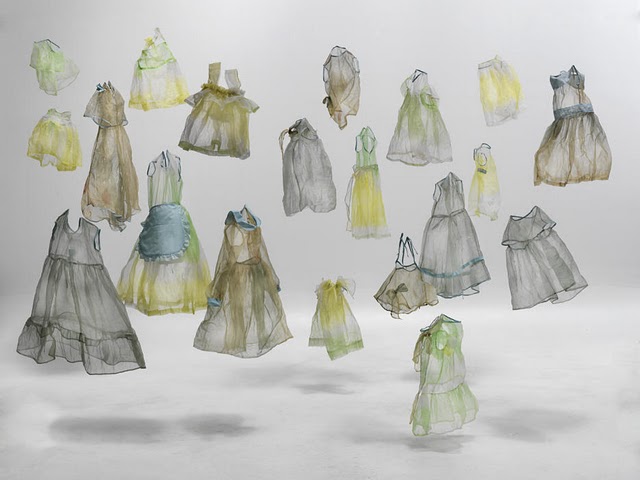Guest blogger Luise Guest takes a look at White Rabbit’s latest exhibition Beyond The Frame…
The latest exhibition of Chinese contemporary art at White Rabbit Gallery provides much to think about, and on my three visits so far has caused some ‘robust discussions’ (i.e. loud and impassioned conversations verging on argument) with friends and family. This show has a very different mood from previous exhibitions. It presents some entirely new works, as well as others which have been shown in previous exhibitions, which look quite different in their new context. The mood is certainly darker and in some ways less exuberant, although who could fail to be amused, intrigued and enthralled by Liu Di‘s ‘Animal Regulation Series‘? Comically fat-bottomed giant creatures (a frog, a hare, a panda, a deer) are trapped within the courtyards of Beijing apartment blocks under construction (or, possibly, this being Beijing, demolition) in order to make a comment on the conflict between nature and ‘civilisation’, a particularly pressing issue in China.
On my three visits to the gallery people were gathered, laughing, in front of another very engaging work, Chen Hangfeng‘s ‘Invasive Species: Vegetables‘ with its noisy electronic dialogue between the plants growing in one of Shanghai’s illicit community vegetable gardens. ‘Eggplant‘ is like a big, dumb, bully character, whilst ‘Bok Choi‘ is more conciliatory. Their talk is raunchy and sexual, or maybe, these being vegetables, ‘earthy’ might be a better description. ‘Heh heh’, says Water Spinach, ‘I already left my seeds in the earth!’ Surprisingly, perhaps, this tongue- in-cheek video work is about civil disobedience. Technically illegal (although at times authorities turn a blind eye) community vegetable gardens allow local residents to exert at least some control over food safety and food prices, significant issues in China.
I met Chen Hangfeng in his studio in Weihai Lu in Shanghai in April this year, when he had just returned from a residency in Japan. His work refers specifically to his local Shanghai context and the pressing social and political issues in a city of great and growing wealth. However he is also fascinated by the Chinese tradition of the scholar and the literati, and much of his work uses ancient folk traditions such as paper cutting, with a satirical twist whereby the patterns reveal themselves to be the signs of global branding: Nike, Adidas, McDonalds et al, such as in his ‘Logomania’ series. These works indicate an interesting shift towards greater subtlety and more layered meanings in contemporary Chinese art compared to the more obvious ‘political pop’ works of earlier artists such as Wang Guangyi.
Chen Hangfeng in his Shanghai studio, photographed by Luise Guest, image reproduced with the permission of the artist.
As I discovered in conversation with Hangfeng over cups of flower tea in his studio, a consistent thread running through his practice is the use of found and discarded materials. Not as a self-conscious art reference to Duchamp, dada or Arte Povera, but as a very deliberate statement about over consumption, materialism, greed and the culture of desire that we all live in, and are implicated in, both Western and non-Western alike. I ask him whether he would define his work as political, and his reply is an emphatic ‘Yes’. Recently he has been revisiting the art of calligraphy and has studied the traditional manual of the ‘Mustard Seed Garden’. His work, ‘Wind from West‘ is a response to this ancient and scholarly form, transformed with his choice of materials – plastic shopping bags. His intention with this work was to create a metaphor for the fact that the essence of Chinese tradition is still there but is now hard to find, or is now viewed only in very superficial ways in this ‘new China’, something also seen in his ‘vegetable soap opera‘ now showing at White Rabbit.
You can get them / ??? from Hangfeng Chen on Vimeo.
Despite the immediate pop-culture appeal of his work, Chen Hangfeng is intending to make a serious point about the working conditions and wages of those who make the common everyday objects ‘made in China’ available so cheaply to consumers in the west, and about the way China is perceived as a source of cheap labour and a market for raw material. Most particularly this is seen in ‘You Can Get Them‘, a video work in which he becomes a comical version of the multi-armed Goddess of Mercy, or Bodhisattva, Guan Yin but in each of the hands (Chen and friends providing the arms) is an item from the supermarket, an assortment of plastic objects ranging from toy guns to fly swatters and coat hangers, “made in China’.
Chen Hangfeng, ‘You Can Get Them’, still from performance video, 2009, image reproduced from artist’s web site with the permission of the artist
Other memorable works in ‘Beyond the Frame‘ include the harrowing photographic documentation of life in Myanmar Prison Camps by Lu Nan, and the profoundly melancholy and touching ‘Mental Patients‘ by Lu Zhengyuan, who spent two weeks in a Beijing psychiatric hospital taking care of a friend. These grey, staring, life size characters distil the despair of the long term inmates. They reminded me irresistibly of Chang Chien-Chi’s photographic installation ‘The Chain‘, shown in Singapore 3 years ago, which records the misery of patients at the Long Fa Tang Temple (both sanctuary and prison) in Taiwan, where patients are chained in pairs as a kind of ‘therapy’.
My two favourite works, however, touch more lightly upon aspects of human experience, both universal and particular. ‘Calm’ by the ‘Made in‘ collective appears at first to be a room sized pile of rubble, roughly rectangular in shape, perhaps detritus from a building site or demolition zone. Only after standing quite close and looking for a while does one see that it appears to be very, very gently rising and falling, undulating from one end to another, or ‘breathing’. Unexpected and slightly unsettling, this work suggests that what we expect to see is not always what we do see, and the world is filled with inexplicable beauty for those who take the trouble to look more closely. Finally my all-time favourite, ‘Exuviate 2: Where have all the children gone?‘, Jin Nu’s 2005 installation of ghostly apparitions – 20 tiny starched organza children’s dresses, turning gently in the slightest shift of air current, swaying and moving as if sighing or crying in an elegy of mourning for lost childhoods. The artist denies any connection with the one child policy and the countless little girls who were never born. This may be a good demonstration, though, of the fact that the meaning of an artwork does not lie in the hands of the artist alone, but is ours to ponder and interpret. Discarded clothing, especially children’s clothing, is filled with so many multiple meanings of loss and mourning, even if it is the sadness of the child grown away from the security and safety of the family, or the mother regretting the quick passage of time and the loss of her children to the adult world.
Jin Nu, ‘Exuviate 2: Where Have All the Children Gone?’ 2005, starched silk, image reproduced with permission of White Rabbit Gallery
Beyond the Frame? More than the works by ‘stars’ such as Ai Weiwei, these works made me think beyond my comfortable Australian ‘frame’ of reference.
Luise Guest is a Sydney based art teacher and blogger who has been writing about Chinese contemporary art since her trip to China early in 2011 on a NSW Premier’s research scholarship. Spending time in Beijing, Shanghai, Guangzhou and Hong Kong she met and interviewed more than 20 artists, curators, academics and art writers. She is now an obsessive Sinophile attempting to learn Mandarin and impatiently planning future trips to China. Her blog: www.anartteacherinchina.blogspot.comReprinted with kind permission of the author.



